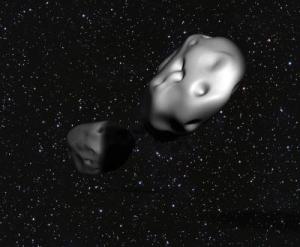Jan 9 2014
Students in a University of Maryland undergraduate astronomy class have made a rare discovery that wowed professional astronomers: a previously unstudied asteroid is actually a pair of asteroids that orbit and regularly eclipse one another.
 In this artist's rendering, the newly-identified binary asteroid 3905 Doppler approaches an eclipse as the larger asteroid begins to pass in front of the smaller one, as seen from a vantage point on Earth. Credit: Illustration: Loretta Kuo
In this artist's rendering, the newly-identified binary asteroid 3905 Doppler approaches an eclipse as the larger asteroid begins to pass in front of the smaller one, as seen from a vantage point on Earth. Credit: Illustration: Loretta Kuo
Fewer than 100 asteroids of this type have been identified in the main asteroid belt between Mars and Jupiter, said Melissa Hayes-Gehrke, who teaches the hands-on class for non-astronomy majors in which eight students made the find in the fall semester 2013.
The students' discovery that 3905 Doppler is an eclipsing binary asteroid will be presented in a poster session Jan. 7 at the 223rd meeting of the American Astronomical Society in National Harbor, Maryland and published in April in the Minor Planet Bulletin.
"This is a fantastic discovery," said University of Maryland Astronomy Prof. Drake Deming, who was not involved with the class. "A binary asteroid with such an unusual lightcurve is pretty rare. It provides an unprecedented opportunity to learn about the physical properties and orbital evolution of these objects."
"Actually contributing to the scientific community and seeing established scientists getting legitimately excited about our findings is a very good feeling," said Terence Basile, a junior from Beltsville, MD majoring in cell biology.
One of hundreds of thousands of pieces of cosmic debris in our solar system's main asteroid belt between Mars and Jupiter, 3905 Doppler was discovered in 1984, but over the coming decades it attracted scant attention. In September 2013 Hayes-Gehrke's students picked it and two other asteroids from an astronomy journal's list of asteroids worth observing because they were well positioned in the autumn sky and were scientific enigmas.
Student teams studying 3905 Doppler met over four nights in October 2013. Each four-person team observed and photographed the asteroid, using a privately owned telescope in Nerpio, Spain, which they accessed and controlled over the internet. Their main task was to photograph changes in the intensity of each asteroid's reflected light and turn those images into a lightcurve.
A lightcurve is a graph of a celestial object's brightness over time. Variations in brightness are often due to the object's shape, with spherical objects like planets yielding lightcurves that do not vary, and asymmetrical objects like asteroids producing peaks and valleys as the amount of reflected light varies. By measuring the time between maximum light intensities, planetologists can tell how fast an asteroid is rotating. Most asteroids complete a rotation in a few hours to a day.
"When we looked at the images we didn't realize we had anything special, because the brightness difference is not something you can see with your eyes," Hayes-Gehrke said. But when the two teams studying 3905 Doppler used a computer program to chart its lightcurve, they found the asteroid's light occasionally faded to nearly nothing.
"It was incredibly frustrating," said Alec Bartek, a senior physics major from Brookeville, MD. "For some reason our light curve didn't look right."
It was as though the rotating rock had suddenly gone dark – and Hayes-Gehrke suspected that's exactly what was happening. She thought 3905 Doppler was actually two asteroids orbiting one another. When one of the two asteroids blocked the telescope's view of its companion, the result was an asteroid eclipse – and a sharp dip in the light curve.
An amateur astronomer in Italy who was viewing 3905 Doppler at about the same time shared his data with the students. Observations by the Italian, Lorenzo Franco, confirmed the lightcurve came from a binary asteroid.
"Even then I was not fully aware of how special the discovery was," said sophomore economics major Brady Bent of Arbutus, MD. "I thought it just meant we would have to do more work. As we continued to analyze our data, other professors in the Astronomy Department came over to view our work. At this point I understood just how rare our find was."
The two asteroids are probably roughly potato-shaped and pocked with impact craters made by strikes from other space debris, Hayes-Gehrke said. The smaller one is about three-quarters the length of the larger one. They orbit each other end to end. Each orbit takes 51 hours – an unusually long time and one the student researchers can't explain. Now that the students have shown how unusual the asteroid is, it's likely that other astronomers will study it.
"Picking the asteroid was luck," Hayes-Gehrke said. So was the fact that the students' camera happened to record an eclipse. But then the students used the same problem-solving techniques a professional astronomer would use to explain an unexpected finding.
"That's the whole point of the class," Hayes-Gehrke said. "I'm hoping they'll keep in mind, when they read about scientific results, that it's not a cut-and-dried process, but the scientist probably had to go through some kind of struggle to get results."